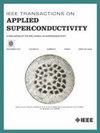Modelling of a Large-Scale Non-Insulated Non-Planar HTS Stellarator Coil Using Quanscient Allsolve
IF 1.7
3区 物理与天体物理
Q3 ENGINEERING, ELECTRICAL & ELECTRONIC
引用次数: 0
Abstract
Stellarators present features such as steady-state operation and intrinsic stability that make them more attractive than tokamaks in their scaling to fusion power plants. By leveraging more possible configurations, stellarators can be optimized for better engineering feasibility, e.g., resilience to manufacturing tolerances, reduced mechanical load on conductor, material optimization, cost of fabrication. Finite Element Analyses are crucial for the design and optimization of High-Temperature Superconducting (HTS)大尺度非绝缘非平面高温超导仿星器线圈的全解建模
仿星器具有稳态运行和内在稳定性等特点,这使得它们在扩展到核聚变发电厂方面比托卡马克更具吸引力。通过利用更多可能的配置,仿星器可以优化为更好的工程可行性,例如,对制造公差的弹性,减少导体上的机械负荷,材料优化,制造成本。有限元分析是高温超导(HTS) REBCO非平面线圈设计和优化的关键。然而,大规模的静磁、机械和淬火模型的精确模拟可能需要数天甚至数周的时间来计算。在这项工作中,我们提出了一个实际尺寸,高温超导,非绝缘,非平面仿星器线圈的模型,并在Quanscient Allsolve®中进行了瞬态仿真研究,包括建模淬火,使用$H - \varphi $公式。结果表明,瞬态模型从内置的区域分解方法(DDM)中获益颇多,可以达到合理的计算时间。这样的模型在预测和理解非绝缘大型REBCO磁体的复杂行为,包括其内在的能量不平衡方面变得非常宝贵。
本文章由计算机程序翻译,如有差异,请以英文原文为准。
求助全文
约1分钟内获得全文
求助全文
来源期刊

IEEE Transactions on Applied Superconductivity
工程技术-工程:电子与电气
CiteScore
3.50
自引率
33.30%
发文量
650
审稿时长
2.3 months
期刊介绍:
IEEE Transactions on Applied Superconductivity (TAS) contains articles on the applications of superconductivity and other relevant technology. Electronic applications include analog and digital circuits employing thin films and active devices such as Josephson junctions. Large scale applications include magnets for power applications such as motors and generators, for magnetic resonance, for accelerators, and cable applications such as power transmission.
 求助内容:
求助内容: 应助结果提醒方式:
应助结果提醒方式:


